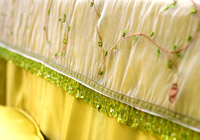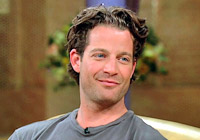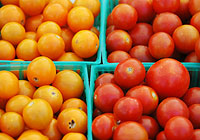Photography Tips
Oprah's personal photographer, George Burns, has traveled with her all over the world taking pictures of amazing people and places. Here is his advice for creating unforgettable photos that you and your family will cherish.
General Advice | Lesson 1 | Lesson 2
Tricks of the TradeGeneral Advice | Lesson 1 | Lesson 2
Lesson 1: Composition
Without good composition your photos don't stand a chance. George talks about framing your shot, paying attention to the background and why love is in the details.
Lesson 2: Lighting
One of the most important aspects of a great photograph is lighting. When should you use a flash, and when do you skip it? George
explains.
General Advice
Think you know everything about megapixels and film speed? How about enemies that wreak havoc on your equipment? George makes sense of your camera conundrums.
Setting Picture Size
George says that when shooting with a digital camera people tend to get tied up in the mega pixels. "If all you are going to do is e-mail photos you don't need a camera that is 10 or 12 megapixels," says George. "However, if you are going to have prints made up to size 8x10, you do want a camera that goes up to 5 mexapixels, which offers plenty of resolution."
Picking Film
All film has a number associated with it that indicates how sensitive that film is to light—the higher the number the more light sensitive the film is. Keep this guideline in mind when picking your film.
100 or 200 speed: Lower-speed films are ideal for shooting in sunny situations like at the beach or in the snow.
400: This all-purpose film is excellent for general picture taking in many situations.
800 or 1000: High-speed film captures light fast. Use this type of film for a cloudy day or low-light situations.
Pay attention to expiration dates! When film expires the quality of your photos will suffer. George suggests storing your film in the refrigerator or freezer. "Film doesn't age if it is frozen," says George. Be sure to bring the film out of the fridge an hour or two before shooting—the night before if it's been in the freezer—so it can come up to room temperature.
Camera Care
"Dust is the biggest enemy of digital cameras," says George. He suggests using canned air to keep your camera clean—and be sure to put your camera in a safe place when you are finished using it. An inexpensive camera bag will do the trick. At the end of every shoot, George breaks down his equipment and keeps it in a safe place so dust can't sneak in.
George says you should also avoid alcohol based cleaners or heavy solvents. Cameras have plastic components so you don't want to use anything that will damage the parts.
When using lens cleaner, avoid putting the cleaner directly on your camera. Instead, put the substance on a soft cloth and wipe down the lens. Otherwise, the liquid could seep into the body of your camera—and that could be disastrous.
Go to lesson 1
George says that when shooting with a digital camera people tend to get tied up in the mega pixels. "If all you are going to do is e-mail photos you don't need a camera that is 10 or 12 megapixels," says George. "However, if you are going to have prints made up to size 8x10, you do want a camera that goes up to 5 mexapixels, which offers plenty of resolution."
Picking Film
All film has a number associated with it that indicates how sensitive that film is to light—the higher the number the more light sensitive the film is. Keep this guideline in mind when picking your film.
100 or 200 speed: Lower-speed films are ideal for shooting in sunny situations like at the beach or in the snow.
400: This all-purpose film is excellent for general picture taking in many situations.
800 or 1000: High-speed film captures light fast. Use this type of film for a cloudy day or low-light situations.
Pay attention to expiration dates! When film expires the quality of your photos will suffer. George suggests storing your film in the refrigerator or freezer. "Film doesn't age if it is frozen," says George. Be sure to bring the film out of the fridge an hour or two before shooting—the night before if it's been in the freezer—so it can come up to room temperature.
Camera Care
"Dust is the biggest enemy of digital cameras," says George. He suggests using canned air to keep your camera clean—and be sure to put your camera in a safe place when you are finished using it. An inexpensive camera bag will do the trick. At the end of every shoot, George breaks down his equipment and keeps it in a safe place so dust can't sneak in.
George says you should also avoid alcohol based cleaners or heavy solvents. Cameras have plastic components so you don't want to use anything that will damage the parts.
When using lens cleaner, avoid putting the cleaner directly on your camera. Instead, put the substance on a soft cloth and wipe down the lens. Otherwise, the liquid could seep into the body of your camera—and that could be disastrous.
Go to lesson 1
Framing the shot
One of the most important aspects of photography is framing the shot. Oprah's personal photographer, George Burns says many people tend to center the subject right in the middle of the frame, but that isn't always the best strategy. "I like the idea of the subject being off to the side because it creates a much more interesting story," says George. By making your subject off center you are essentially forcing people to scan the whole photograph—letting them take in the entire scene.
Another important step is to be sure and get some candid shots. You don't always want people posing for the camera or you'll lose the emotion of the moment. "I never put the camera down when we're taping. I always try to catch the moment, when someone cries or an expression. That is what tells the story," says George. While holding onto the camera for an entire party isn't always possible, you can make the most of your photographs by being tricky. Sneak up on people when possible, or shoot from across the room using the zoom to get some good action shots when they least expect it.
In this photo, Matthew McConaughey is center of attention, but there is no indication of where he is or what he is doing.
By moving Matthew to the side, you can see that he is in a region devastated by Hurricane Katrina, and the emotion of the picture shines through.
Remember the details | Be aware of backgrounds
One of the most important aspects of photography is framing the shot. Oprah's personal photographer, George Burns says many people tend to center the subject right in the middle of the frame, but that isn't always the best strategy. "I like the idea of the subject being off to the side because it creates a much more interesting story," says George. By making your subject off center you are essentially forcing people to scan the whole photograph—letting them take in the entire scene.
Another important step is to be sure and get some candid shots. You don't always want people posing for the camera or you'll lose the emotion of the moment. "I never put the camera down when we're taping. I always try to catch the moment, when someone cries or an expression. That is what tells the story," says George. While holding onto the camera for an entire party isn't always possible, you can make the most of your photographs by being tricky. Sneak up on people when possible, or shoot from across the room using the zoom to get some good action shots when they least expect it.
In this photo, Matthew McConaughey is center of attention, but there is no indication of where he is or what he is doing.
By moving Matthew to the side, you can see that he is in a region devastated by Hurricane Katrina, and the emotion of the picture shines through.
Remember the details | Be aware of backgrounds

Pay attention to the details.
As Oprah says, "love is in the details" and the same theory goes for photography. When George shoots events, he pays special attention to the little things—like the bow on a wedding dress, a party favor or the flowers. "You don't want 200 pictures of people standing next to each other. You want to get a feel of the room...of the details," says George. Capturing the emotion of the event is crucial to keeping your memories fresh and vibrant.
At Oprah's Legends Weekend, George was careful to shoot all the little details that made the event extra special. Here he captured the beautiful beadwork on the tablecloths.
Here, George got a great shot of the Lemon Drop martini's the guests enjoyed. With photos like these, everyone will remember all aspects of the magnificent event!
Be aware of backgrounds | Framing the shot
As Oprah says, "love is in the details" and the same theory goes for photography. When George shoots events, he pays special attention to the little things—like the bow on a wedding dress, a party favor or the flowers. "You don't want 200 pictures of people standing next to each other. You want to get a feel of the room...of the details," says George. Capturing the emotion of the event is crucial to keeping your memories fresh and vibrant.
At Oprah's Legends Weekend, George was careful to shoot all the little details that made the event extra special. Here he captured the beautiful beadwork on the tablecloths.
Here, George got a great shot of the Lemon Drop martini's the guests enjoyed. With photos like these, everyone will remember all aspects of the magnificent event!
Be aware of backgrounds | Framing the shot

Be aware of backgrounds.
Another important aspect to shooting a great picture is being aware of your background. More times than not, people are so focused on the subject of the photograph that they don't pay attention to what is going on behind the action. "Sometimes you have to look over your subject. Look behind the subject a little bit and see what is there. Maybe just changing the angle will make a much more visually interesting picture," says George.
One of the most common mistakes amateur photographers make is shooting a picture and accidentally getting a tree branch or umbrella stand in the shot. Oftentimes that branch can look like it is coming out of someone's head!
In this photo it looks like designer Nate Berkus has a plant coming out of his head!
By moving the camera angle, Nate is in the clear!
Remember the details | Framing the shot
Another important aspect to shooting a great picture is being aware of your background. More times than not, people are so focused on the subject of the photograph that they don't pay attention to what is going on behind the action. "Sometimes you have to look over your subject. Look behind the subject a little bit and see what is there. Maybe just changing the angle will make a much more visually interesting picture," says George.
One of the most common mistakes amateur photographers make is shooting a picture and accidentally getting a tree branch or umbrella stand in the shot. Oftentimes that branch can look like it is coming out of someone's head!
In this photo it looks like designer Nate Berkus has a plant coming out of his head!
By moving the camera angle, Nate is in the clear!
Remember the details | Framing the shot

Flash or No Flash?
When should you use a flash, and when can you skip it? George says you should always use a flash. "I use the flash outside almost all the time. It is hard to be in the sun when it is perfectly even. The sun will leave shadows," says George.
Don't forget! When using a flash be aware of your surroundings. If you use a flash in front of any kind of glass, including mirrors, the light will bounce back and ruin your picture. Instead of shooting straight on, try taking your picture at an angle!
These tomatoes were shot with no flash.
These tomatoes were shot in the sun with a flash.
The Sun
Also, pay attention to the sun. A good rule of thumb is to make sure the sun is positioned behind you when setting up a shot, otherwise your subject can be overexposed.
Low-Light Conditions
When shooting in low-light or at night, George suggests shooting at a lower shutter speed (to keep the picture in focus you may need to use a tripod, or balance your camera on a fence or table). Most cameras have settings for shooting at night, which oftentimes does work, says George.
Lesson 1: Composition
When should you use a flash, and when can you skip it? George says you should always use a flash. "I use the flash outside almost all the time. It is hard to be in the sun when it is perfectly even. The sun will leave shadows," says George.
Don't forget! When using a flash be aware of your surroundings. If you use a flash in front of any kind of glass, including mirrors, the light will bounce back and ruin your picture. Instead of shooting straight on, try taking your picture at an angle!
These tomatoes were shot with no flash.
These tomatoes were shot in the sun with a flash.
The Sun
Also, pay attention to the sun. A good rule of thumb is to make sure the sun is positioned behind you when setting up a shot, otherwise your subject can be overexposed.
Low-Light Conditions
When shooting in low-light or at night, George suggests shooting at a lower shutter speed (to keep the picture in focus you may need to use a tripod, or balance your camera on a fence or table). Most cameras have settings for shooting at night, which oftentimes does work, says George.
Lesson 1: Composition



